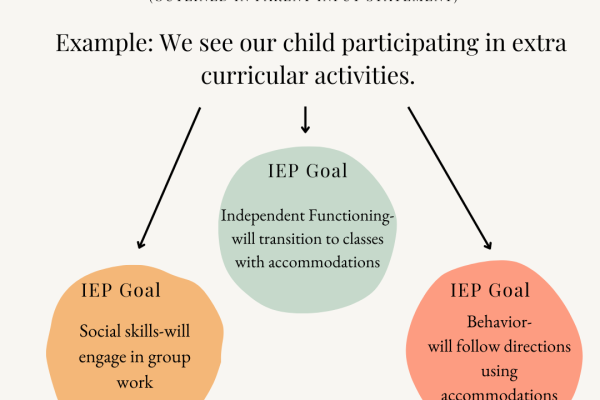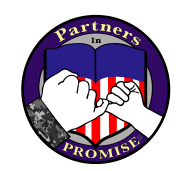
Your Vision for the Future Drives Your Child’s IEP
| IEP, IEP Meetings
By Jessica Monteverde
“When I look at you and you look at me, I wonder what wonderful things you will be.”
-Emily Winfield Martin from her book The Wonderful Things You Will Be
We read this book last night before bed. This quote stops me in my tracks every time. How quickly my days fly by with my little ones. I don’t have much time for long-term thinking with the daily demands of keeping three very small people fed, happy and somewhat clean. However, every time I read this quote, I spend the rest of the book daydreaming about what my three precious girls will become and how to make my vision for the future a reality.
Did you know every time you sit down at the IEP table, you and the other Individualized Education Program (IEP) team members are wondering what wonderful things will your child do? Who will they grow up to be? Who do they want to grow up to be? And most importantly, how are we going to help them become that wonderful person?
Special education is pretty cool because it puts real steps in place to bring these wonderful goals to fruition. However, to put these steps into action, the topic of the future must be discussed at IEP meetings and then written into the IEP. The main objective of an IEP is to prepare your child for FURTHER education, employment and independent living. Below are the three parts of the IEP that can ensure the IEP is preparing your child for the future.
Parent Input Statements
The parent input statement, sometimes titled “Parent Concerns” or something to that effect, is the area of the IEP used to address the future from the parent’s perspective. This is an area that is often overlooked in the IEP, or by simply including a short sentence summarizing a parent’s concerns. Sometimes it becomes the “parent’s complaints” section.
However, the parent input statement should be the driving force behind the whole IEP. It is your vision for the future of your child and would be better named “parent vision.”
The input statement should highlight what your goals are for your child’s education, employment and independence. Writing this statement, a concise paragraph, before the IEP meeting and submitting it to the IEP team via email will ensure your thoughts are addressed and keep the team focused on the most important needs of your child. Sending it via email will ensure that it is documented. Consider addressing academics (basic reading and math skills?), social skills (making friends, holding a conversation) and independence (toileting, eating, following a schedule, completing tasks alone or self-advocacy skills). Remember to send your thoughts to the IEP team, so there are no surprises and the team will know what areas you would like to discuss.
IEP Goals – Getting You to Your Vision for the Future
As a teacher I can assure you, your insight is valued throughout the entire IEP, not just in places labeled “parental input.” When looking at the IEP goals, consider if each goal is helping achieve the goals you outlined in the parent input statement. Request a draft IEP before the meeting to give yourself a chance to consider if the current IEP goals support your vision for the future.
Transition Plans
According to the Individuals with Disabilities Education Act (IDEA), a transition plan must be developed by the time the child turns 16. In many states, the age is earlier around age 14, right before entering high school. The transition plan should consider your child’s future goals, along with those of the parent. Concrete steps should be put in place to help a child reach their goals beyond high school.
Through the transition process, the school may be in touch with others in the community to help in achieving post-secondary goals. If your child does not have a plan and they are of age, request for the team to develop one immediately. If your child has one, but it is not being implemented, start a conversation to ensure it is being utilized. The transition plan is where concrete steps are put in place to help your child become the wonderful person they are meant to become.
Do not bypass this part of the IEP!
Not only is it required by law, but also because it facilitates steps for your child’s future success whatever that looks like for him/her.
As a military family that transitions frequently, it is critical that you, the parent, become the voice of your child’s IEP. You are the most consistent and influential member of the IEP team, every time. All the other roles will change, and change frequently. Sharing your vision for your child’s future will create clarity and help in forming a clear path for your child’s education. Above all else, communicate with your child’s IEP team and do not be afraid to share your insight! It is valued.
You are the driving voice of your child’s education. Consider what wonderful things you envision them becoming so that your child’s IEP truly reflects preparedness for future education, employment and independent living.
About the Author

Jessica is a special education teacher turned military wife and stay-at-home mom as her little ones grow. She holds a Masters’s degree in Special Education and has completed the Master IEP Coach® Mentorship Program. Jessica provides special education coaching and consulting services for families with IEPs, 504s or those in the evaluation process. She supports parents in becoming the greatest advocate for their children by building collaborative relationships, providing education on strategies for success at school and home and assisting in transitions. She especially enjoys walking with fellow military families through their child’s educational journey as she fully understands the extra challenges.
Connect with Jessica: jessicamonteverde.com
Email: jlmonteverde@successfulhealthychildren.org
Facebook/Instagram at: jmonteverde.iepcoach and LinkedIn: Jessica Monteverde M.Ed.





Love this and love it!